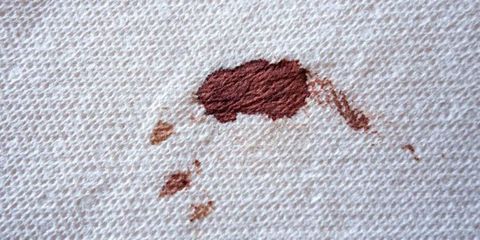Removing Blood Stains From Clothes

Removing Blood Stains From Clothing In 5 Easy Steps
Accidents happen. Whether you cut yourself while cooking, shaving, or any number of ways in the house, spilled blood can be a real pain in the neck. It’s messy, gross and stains everything it touches. While larger accidents – accidents that affect multiple areas of the home or where blood has pooled – require professional services like those provided by Aftermath Services, a few small blood droplets on clothes can be treated using simple home remedies.
Keep in mind that as blood dries, the stain sets in, so always clean it up quickly. Here are a few simple steps you can take to most effectively clean small blood stains out of your clothes.
Note: do NOT launder the clothing immediately or use hot water. Heat activates the proteins in blood, causing it to set quickly and permanently stain.
Equipment you’ll need to clean up blood:
- Hand or dish towel
- Cold water
- Mild detergent
- 3% hydrogen peroxide
- Bowl or basin
5 Steps to cleaning small blood stains out of clothes
- Dab: First, dab at the blood using a dampened towel or rag with cold water to remove as much as possible. Don’t scrub. This can push the stain deeper into the fibers. Work from the outside in.
- Soak: Fill up your bowl or basin with a mixture of tepid water and a mild detergent or stain remover. If available, use a detergent specifically designed to combat stains, like Tide Liquid Coldwater or Oxi Clean Versatile Stain Remover Powder. Be cautious with delicate fabrics such as wool, silk, and other dry clean-only clothing. These likely require special attention from a dry cleaners or other professional in order to safely remove the stain. Soak the affected clothing for at least one hour. More severe stains can require a longer soak time, sometimes up to six hours. Avoid using harsh chemicals like bleach as these can damage the fibers and colors of the fabric. Also, do not be tempted to use hot water as this can encourage the stain to set.
- Blot: After soaking in detergent, blot it with 3% hydrogen peroxide. Hydrogen peroxide is a mild bleach, but it is much safer for your clothes and your skin and it will not weaken your fabrics. Some bloggers suggest using a toothbrush to scrub the area with the product. If you choose to do so, be mindful of your fabric and the possibility that this could force the stain deeper into some types of fibers. There may be some fizzing as the hydrogen peroxide works its magic. Following treatment, make sure to completely rinse or wash your fabric in cool water to remove any remaining chemicals before the next step.
- Dry: Let the stain air dry to see if the stain is gone — do NOT use heat. Heat from your dryer can actually set the stain further.
- Repeat: If the stain is still visible, repeat these steps.
Be mindful that these techniques should be used for small blood droplets or stains, and does not provide disinfection of any bloodborne pathogens on the fabric. If the blood stain covers a large area, has started to pool, or is present in multiple areas, it is advised that you call in an expert. A professional biohazard remediation company can provide 100% disinfection of any non-porous surfaces and provide proper disposal of any affected porous items (like clothes or linens).
As the premier biohazard remediation company, Aftermath’s team of skilled technicians are experienced in the protocols and best practices associated with handling any type of biohazard situation. We approach blood cleanup with a scientifically based process. Not only do we remediate all visible stains and invisible pathogens, we also test every site for 100% disinfection levels to ensure that no microorganism is left behind to cause additional damage or odors.
Have questions about blood cleanup? Speak to an Aftermath representative today.
 877-872-4339
877-872-4339  Contact Us
Contact Us 






